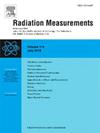用紫外光初始化辐射光致发光玻璃(FD-7)的无热方法的实验研究
IF 2.2
3区 物理与天体物理
Q2 NUCLEAR SCIENCE & TECHNOLOGY
引用次数: 0
摘要
掺银磷酸盐辐射光致发光(RPL)玻璃剂量计(RPLD)被广泛应用于辐射剂量测定。虽然RPLD通过适当的退火具有可重复使用的优点,但目前的退火工艺具有不理想的特点,例如在高温(约400°C)下加热和随后的长时间(近半天)冷却。在这项研究中,我们提出了一种使用紫外线(UV)更安全、快速地初始化rpld的新方法,该方法有望在许多场合,包括放射治疗的质量保证(QA)中更可取。采用尺寸为φ1.5 mm × 12 mm的4个市售RPLD玻璃(FD-7)样品,分别以0.1、0.5、1、2和5 Gy (H2O)的x射线(160 kV, 6.3 mA)照射,并在高压汞紫外线灯下照射,该灯具有宽波长范围,主峰位于365 nm。在室温下,使用专用的RPL读出系统(FDG-1000, Asahi Techno Glass Co., Ltd)以一定的时间间隔测量RPL强度。紫外线照射3小时后,1 Gy及以上照射的RPL强度降低了90%;照射6小时后,2 Gy及以上照射的RPL强度降低了95%。紫外照射终止后,RPL强度略有增加(室温下24 h内增加2%)。根据这些发现,我们期望所提出的初始化rpld的无热方法,即“uv退火法”,将有效地应用于相对高剂量辐射领域的常规剂量测定,包括放射治疗设施。本文章由计算机程序翻译,如有差异,请以英文原文为准。
Experimental investigation of a heatless approach for initializing radiophotoluminescence glasses (FD-7) using ultraviolet light
Ag-doped phosphate radiophotoluminescence (RPL) glass dosimeter (RPLD) is widely used for radiation dosimetry. Although RPLD has the advantage of reusability through proper annealing, the current annealing process has undesirable features, such as heating at a high temperature (approximately 400 °C) and subsequent long (nearly half a day) cooling. In this study, we propose a new approach to initialize RPLDs more safely and rapidly using ultraviolet light (UV), which is expected to be preferable in many occasions, including quality assurance (QA) for radiotherapy. Four samples of commercially available RPLD glass (FD-7) with a size of φ1.5 mm × 12 mm were irradiated with X-rays (160 kV, 6.3 mA) at 0.1, 0.5, 1, 2, and 5 Gy (for H2O) and exposed to UV from a high-pressure mercury UV lamp, which has a broad wavelength range with a dominant peak at 365 nm. RPL intensities were measured using an exclusive RPL readout system (FDG-1000, Asahi Techno Glass Co., Ltd.) at certain time intervals at room temperature. After 3-h UV exposure, the RPL intensity decreased by >90 % for irradiation of 1 Gy or higher, and 6-h UV exposure cleared >95 % of the RPL intensity for 2 Gy or higher. The RPL intensity increased slightly (2 % in 24 h at room temperature) after the termination of UV exposure. According to these findings, it is expected that the proposed heatless approach to initialize RPLDs, named ‘UV-annealing method’ here, will be effectively applied to routine dosimetry in relatively high-dose radiation fields, including radiotherapy facilities.
求助全文
通过发布文献求助,成功后即可免费获取论文全文。
去求助
来源期刊

Radiation Measurements
工程技术-核科学技术
CiteScore
4.10
自引率
20.00%
发文量
116
审稿时长
48 days
期刊介绍:
The journal seeks to publish papers that present advances in the following areas: spontaneous and stimulated luminescence (including scintillating materials, thermoluminescence, and optically stimulated luminescence); electron spin resonance of natural and synthetic materials; the physics, design and performance of radiation measurements (including computational modelling such as electronic transport simulations); the novel basic aspects of radiation measurement in medical physics. Studies of energy-transfer phenomena, track physics and microdosimetry are also of interest to the journal.
Applications relevant to the journal, particularly where they present novel detection techniques, novel analytical approaches or novel materials, include: personal dosimetry (including dosimetric quantities, active/electronic and passive monitoring techniques for photon, neutron and charged-particle exposures); environmental dosimetry (including methodological advances and predictive models related to radon, but generally excluding local survey results of radon where the main aim is to establish the radiation risk to populations); cosmic and high-energy radiation measurements (including dosimetry, space radiation effects, and single event upsets); dosimetry-based archaeological and Quaternary dating; dosimetry-based approaches to thermochronometry; accident and retrospective dosimetry (including activation detectors), and dosimetry and measurements related to medical applications.
 求助内容:
求助内容: 应助结果提醒方式:
应助结果提醒方式:


